 |
 |

 |
| “Why
is my system humming?” |
 |
|
Because
it doesn't know the words, of course! (boom boom) But
seriously, several things can cause a system to hum, in this
article though, I shall address the eternal mystery of Ground-loops
(AKA Earth-Loops). These are the major cause of hum (and
other problems) in Hi-Fi systems, and probably the most common
and widely mis-understood of faults.
Many audiophiles have tried curing hum by adding extra earth
wires - sometimes tying them to the cold-water pipe - sometimes
even driving copper stakes into the dirt... but in reality
the cause is usually TOO MANY earth connections, not too few!
Usually, this comes from the fact that, in this country, the
regulation mains-plug has 3 pins, Active, Neutral and EARTH.
With respect to any single device, this is a good thing, because
it adds an extra element of electrical safety.
But when you connect several audio components together, they
form a SYSTEM and it is important for this system to have
a logical SYSTEM GROUND -- otherwise, it will just have a
mish-mosh of un-planned earth connections, depending on your
particular mix of components and their respective power cables.
Once the simple "Ground Rules" are understood, you
will be able to banish ground-loops and their nasty effects
from your system forever! Once again, let's go back
to the basics.
|
|
 |
| Audio
Signal Basics |
 |
|
We
like to think it's music going through our wires, but it's
actually just an electric current flowing in a circuit between
say, your CD player and your amp. It's called a circuit
because electric currents always follow a circular path (logically,
not physically). The electric current in this circuit
is the 'analogue' of the music signal it represents.
|
|
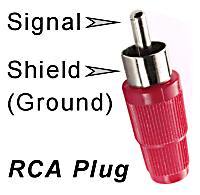 |
The
standard for unbalanced audio connections in Hi-Fi is the
RCA plug. With the exception of a small handful of European
brands, just about everything connects with these.
The centre pin carrys the music signal which travels down
the centre of the cable. The outer ring completes the
circuit by providing the return path, via the 'shield' which
usually takes the form of a wire braid wrapped around the
signal wire.
In unbalanced circuits, the return path is always the unit's
'Ground' - which means that the outer ring is ultimately connected
to the component's metal chassis.
|
|
|
As
mentioned above, the connection between your CD player and
your amp is a circuit because electric currents always follow
a circular path. This electric current (the analogue of your
music signal) travels down the centre of the cable and returns
via the outer shield... or does it?
Electricity ALWAYS follows the line of least resistance --
and we know that the shield which is supposed
to be the return-path for the signal is also connected to
the chassis and the chassis is connected to the Earth pin
of the mains plug. So...
what happens if the mains cable has less resistance than the
shield of your RCA cable? Well, it becomes part of the
signal path - that's what!
|
|
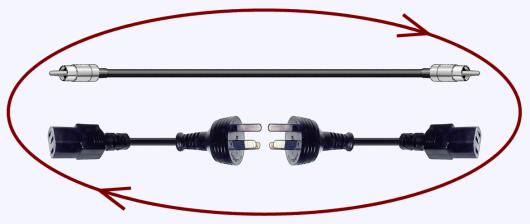
|
|
The
signal current returns, not via the shield, as it should -
but via the mains cables which are connected together by your
power-board - and in the process, it picks up noise from the
mains, resulting in the sound that we know as HUM.
But hum is not the only potential problem here... remember,
the Earth pin of the power plug, is also connected via the
house-wiring to your TV, the fridge, the microwave, the computer,
the power pole in the street, the house next door, the butcher,
the baker... you get the drift. In theory, in "a
perfect world", the Ground is meant to be SILENT... but
guess what?... it ain't a perfect world!
A ground-loop can cause your system to pick up all manner
of electrical garbage - and in extreme cases, it can even
result in instability and catastrophic failure.
|
|
|
So...
What's the solution?
Consider the diagram on the right, and notice how it resembles
a tree with a root, a trunk and some branches.
If your system ground is structured in this way, ground-loops
are eliminated. All units are grounded to the pre-amp
via their interconnects, and ONLY the pre-amp connects to
mains Earth, preferrably via the best power cable you have
on hand.
|
  |
|
Alternatively,
this arrangement will work if you have a power amp with heavy
mains cable -- you can use it as the 'trunk' of the tree.
Remember, this is a map of our system ground only,
not the power connections or the signal path.
The general tree-shaped map still applys, regardless of your
particular setup.
|
 |
|
|
Removing
any additional ground wires forces the signal currents to
do what they should
i.e. to return via the correct path, the interconnect shields...
BUT
Before you take a hacksaw to the Earth pins on your mains
cables...
make sure you know what you're doing
|
|
|
 |
| How
to Fix it |
 |
|
First,
be aware that ground-loops are only responsible for hum about
95% if the time. If the hum you are hearing is coming
from inside a faulty component, no amount of mucking about
with cables is going to cure it. Hum can also mean you
have a faulty cable somewhere. So you should first try
a couple of tests.
"The Hard Way" (recommended
if all else fails)
To test where the hum is coming from, you can try disconnecting
EVERYTHING except the power amp and speakers, and then switch
on the amp and listen closely to the speakers. If it
has NOTHING ELSE connected to it, the amp should not hum...
if it does, then the amp is faulty, pure and simple (so call
me, I'll fix it, OK?).
If there's no hum, switch off, connect the pre-amp ONLY to
the power amp and once again, switch on and listen to the
speakers. Keep repeating the above procedure, each time
adding another component until you find the one that makes
the system hum.
"The Easy Way" (try this
first!)
You will need a very sophisticated piece of equipment - and
you have to make it yourself!
|
|
 |
| "The
Floater" |
 |
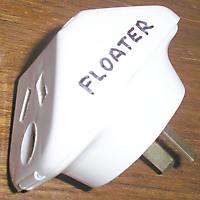 |
Grab
a common old double adapter (the pyramid-shaped ones work
best) and a screwdriver. Undo the screw that holds it
together and pull the entire earth-pin assembly out and then
put it back together.
Throw the earth thingy into the drawer of bits you're keeping
in case they come in handy some day.
Using a CD marker (or similar), write "FLOATER"
(or any scary message that'll stop your spouse using it on
the kettle and the toaster) on the side.
Keep away from children.
|
|
|
Armed
with your Floater and your new 'system ground tree',
seek and destroy all ground-loops. Start by isolating
the source components.
If you're hearing hum in the silences between tracks when
playing a CD, start by isolating the CD's power plug using
the floater.
Always make sure that everything is powered off before unplugging
anything or making any changed to the wiring.
|
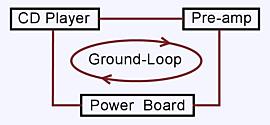
|
|
|
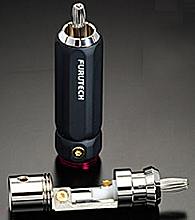
|
Don't
forget that your RCA cables must now earth the floated components,
so make sure they make good contact. If your interconnects
aren't up to the job, then you'll either need to upgrade your
cables... OR
If your cables are high-end but the plugs are just worn out
and sloppy, talk to us about having your cables refurbished
with some high quality plugs, like these gorgeous Furutech
rhodium RCAs. The spring loaded centre pins and locking earth
rings guarantee best possible connection and rhodium is even
better than gold.
That annoying hum will soon be just a bad memory and you won't
believe how good the music sounds against a black background
of silence!
|
|
 |
| RETURN
TO FAQ |
RETURN
TO TOP OF PAGE |
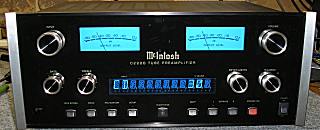
|
|
 |










